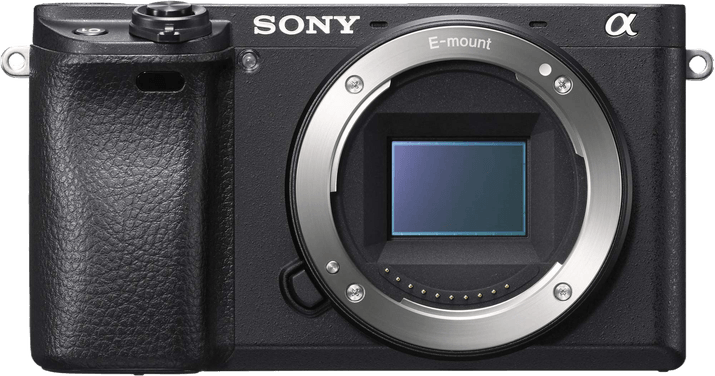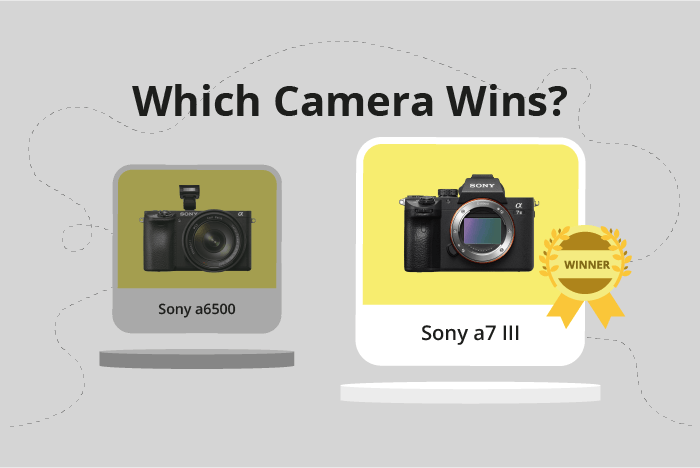Sony a6500 vs a7 III Comparison
Sony a6500

Sony a7 III

The Sony a7 III takes the lead with a score of 81, while the Sony a6500 follows closely at 72/100. Both mirrorless cameras share similarities, such as their camera type and launch prices of $2000 and $1400, respectively.
The Sony a7 III, released in 2018, outshines its competitor with its larger size (127 x 96 x 74mm) and heavier weight (650g). This may provide better stability and handling for users. On the other hand, the Sony a6500, released in 2016, is more compact (120 x 67 x 53mm) and lighter (453g), making it a great option for those who prefer portability.
Considering the specifications, the Sony a7 III proves to be a better choice for users who require a more substantial and stable camera, while the Sony a6500 is ideal for those seeking a compact and lightweight option.
Sony a6500 vs a7 III Overview and Optics
The Sony a7 III emerges as the winner in the optics comparison with a score of 81/100, while the Sony a6500 trails behind with a score of 74/100. Both cameras share similarities, such as the 24.2-megapixel count, CMOS sensor type, Bionz X processor, Sony lens mounts, and image stabilization. However, the Sony a7 III proves to be the superior camera in certain aspects.
The Sony a7 III has a full-frame sensor, which allows for better low-light performance and increased dynamic range compared to the Sony a6500’s APS-C sensor. Additionally, the a7 III boasts a higher DXOMARK score of 96 for its sensor, indicating enhanced image quality. The a7 III also benefits from the Sony FE lens mount, providing access to a broader range of high-quality lenses designed specifically for full-frame cameras.
Although the Sony a6500 falls short in some areas, it does have a faster shooting speed of 11 frames per second (fps) compared to the a7 III’s 10 fps. This advantage makes the a6500 more suitable for capturing fast-moving subjects or events.
In terms of optics, the Sony a7 III outshines the a6500 with its full-frame sensor, higher DXOMARK score, and compatibility with Sony FE lenses. However, the a6500’s faster shooting speed may be more appealing to those who prioritize capturing fast-paced action. Ultimately, the choice between these two cameras depends on the specific needs and priorities of the photographer.
Sony a6500 vs a7 III Video Performance
The Sony a6500 emerges as the winner in the video capabilities comparison, scoring 77/100, while the Sony a7 III scores 70. Both cameras share some common specifications, such as a maximum video resolution of 4K and dimensions of 3840 x 2160. Ad
The Sony a6500 outperforms the Sony a7 III in certain aspects of video performance, most notably the maximum video frame rate. The a6500 can reach up to 120fps, allowing for smoother slow-motion footage and more flexibility in post-production. The a7 III, on the other hand, has a maximum frame rate of 30fps, which is adequate for most situations but does not offer the same level of versatility as the a6500.
Despite the lower overall score, the Sony a7 III has its own strengths. The camera features a full-frame sensor, which can provide a shallower depth of field and improved low-light performance compared to the a6500’s APS-C sensor. This can be advantageous for filmmakers looking to achieve a more cinematic look in their videos.
Taking these factors into account, the Sony a6500 proves to be the superior choice for videographers seeking high frame rates and greater flexibility in post-production. However, the Sony a7 III may still appeal to those who prioritize a full-frame sensor and the potential for improved depth of field and low-light performance. Ultimately, the choice between these two cameras will depend on the individual’s preferences and priorities when it comes to video production.
Sony a6500 vs a7 III Features and Benefits
The Sony a6500 and Sony a7 III both have a feature score of 81 out of 100, making them equal in this aspect. They share several specifications, including a 3-inch screen size, a screen resolution of 921600 dots, touchscreen capabilities, flip screens, and the absence of GPS. Additionally, both cameras have WIFI and Bluetooth connectivity.
The Sony a7 III outperforms the Sony a6500 in some areas. It has a larger full-frame sensor, which allows for better image quality and low-light performance. The a7 III also features a higher resolution electronic viewfinder, providing a clearer and more detailed view when composing shots. Furthermore, the a7 III has a more robust battery life, enabling users to capture more images before needing to recharge.
On the other hand, the Sony a6500 has some advantages over the a7 III. It is a smaller and more lightweight camera, making it more portable and easier to carry around. The a6500 also has a faster continuous shooting speed, which is beneficial for capturing fast-moving subjects or action scenes.
Both the Sony a6500 and Sony a7 III are excellent cameras, each with their own strengths. The a7 III excels in image quality and low-light performance, while the a6500 offers portability and speed. Users should consider their specific needs and preferences when deciding between these two models, as both cameras are capable of delivering high-quality results.
Sony a6500 vs a7 III Storage and Battery
The Sony a7 III outperforms the Sony a6500 in storage and battery with a score of 81, compared to the a6500’s 21/100. Both cameras accept SD/SDHC/SDXC and Memory Stick Pro Duo cards. However, the a7 III has two memory card slots, while the a6500 has only one. Additionally, the a7 III has a longer battery life, providing 750 shots with its NP-FZ100 battery, almost double the a6500’s 350 shots using the NP-FW50 battery.
The a7 III’s superior battery life and dual memory card slots make it the better choice for extended shooting and storage flexibility. The a6500, on the other hand, does not provide any advantages in these aspects. Choosing the a7 III ensures longer shooting sessions and more storage options, making it the clear winner in this comparison.
Alternatives to the Sony a6500 and a7 III
Are you still undecided about which camera is right for you? Have a look at these popular comparisons that feature the Sony a6500 or the Sony a7 III:

